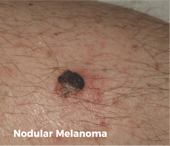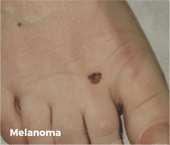Melanoma: everything you need to know
What is melanoma?
Melanoma is a form of skin cancer that usually occurs on parts of the body that have been over-exposed to the sun's harmful UV radiation, but can also (rarely) form in areas that have never been exposed to the sun. It is possible to develop melanoma inside your mouth, under your nails, on the soles of your feet, and even on your eyes.
FACT: Bob Marley died from a melanoma under his toe nail.
How common is melanoma?
Melanoma is the fourth most common cancer in Australia. We have the second highest rate of melanoma in the world after New Zealand, with around 1 in 13 men and 1 in 22 women being diagnosed with the disease by the age of 85.
In 2014, 13,134 melanomas were diagnosed in Australia, and there are around 1,500 deaths from the disease each year.
FACT: Melanoma is the most common cancer in people aged 15 to 39 years.
What are the symptoms of melanoma?
The first symptom of melanoma is usually the appearance of a new spot or a change in an existing freckle or mole, which evolves in size, shape or colour over several weeks or months. The below guidelines are a useful tool for monitoring your own skin to detect the early signs of skin cancer. However, the best way to identify a melanoma is to get a skin check from a professional.
AsymmetryDo the two halves of the lesion match if you draw a line through the middle? |
 |
 |
BorderAre the borders smooth and even or do they have notched and |
 |
 |
ColourDoes the lesion have one colour or a variety of colours? |
 |
 |
DiameterIs the lesion smaller or larger than a pencil eraser (approximately 6mm)? |
 |
 |
EvolvingAre there any changes in size, shape, colour, elevation or any other new |
 |
 |
New moles usually grow and fade during childhood and adolescence. Any new spots that develop during adulthood should be monitored by your doctor.
FACT: Early detection of melanoma increases your chances of survival to 98 per cent.
What causes melanoma?
The leading cause of melanoma is unprotected exposure to the sun's harmful UV radiation, which permanently damages the skin cells and can lead to early signs of ageing (like wrinkles) and skin cancer, including melanoma. If you spend a lot of time outdoors or have ever been sunburnt, especially during childhood, you are at higher risk of developing the disease.
Melanoma can also be hereditary, so if your immediate family members have been diagnosed with melanoma, your own risk increases by around 50 per cent.
Melanoma risk is increased for people who have:
- frequent sun exposure
- an occupation based outdoors
- multiple moles
- a low immune system
- a family history of melanoma
- ever been sunburnt
- fair skin, freckles, light-coloured eyes or light-coloured hair
- a tendency to burn rather than tan
- had melanoma before.
Take our quick quiz to find out if you're at risk.
FACT: There is nothing healthy about a tan. Your skin darkens after sun exposure because your skin cells are in trauma and produce melanin (the pigment that gives your skin its colour) in an effort to protect it from further harm.
How is melanoma diagnosed?
You should monitor your own skin for signs of skin cancer every three months using this self-check guide, and see your doctor at least once a year for a professional full-body skin cancer examination. You may need a skin check more often than this if you are at high risk. At your skin check, your doctor will use a tool called a dermatoscope to thoroughly examine your body from head-to-toe. The doctor may monitor suspicious lesions for changes over time, or perform a biopsy to confirm a diagnosis of melanoma.
Learn more about skin checks or discover everything you need to know about skin biopsies here.
FACT: The first person to notice a skin cancer is usually you or your partner, not a doctor. That's why it is so important to self-monitor your skin and alert your doctor of any changes straight away, even if you are not due for your routine check-up.
Melanoma treatment
 The outcome of a melanoma diagnosis is usually predicted by its thickness. Stage 0 melanomas have a thickness of less than 0.1mm; stage I is less than 2mm; stage II is greater than 2mm; stage III has spread to lymph nodes; and stage IV shows distant spread. If distant spread is suspected, CT scans of the chest, abdomen and pelvis are performed, and a blood test can sometimes assess metastatic disease.
The outcome of a melanoma diagnosis is usually predicted by its thickness. Stage 0 melanomas have a thickness of less than 0.1mm; stage I is less than 2mm; stage II is greater than 2mm; stage III has spread to lymph nodes; and stage IV shows distant spread. If distant spread is suspected, CT scans of the chest, abdomen and pelvis are performed, and a blood test can sometimes assess metastatic disease.
If melanoma is thin and caught early enough, surgery can be enough to cure it. If the melanoma has spread to the lymph nodes, you may need a lymph node dissection to remove them.
Treatment for advanced melanoma, where the cancer has spread to lymph nodes, internal organs or bones, may include surgery, radiation therapy, targeted therapy or immunotherapy.
In some cases, you may need palliative care. Palliative care aims to improve your quality of life by slowing the spread of melanoma, alleviating symptoms, and relieving pain.
FACT: When detected early, the five-year melanoma survival rate is 90 per cent for men and 95 per cent for women.
Preventing melanoma
You can help to prevent melanoma by avoiding sun exposure, especially if the UV Index exceeds 3 and during the middle of the day when UV radiation is most intense. Seek shade whenever possible, wear a hat that covers your ears and neck, wear protective clothing such as long-sleeved shirts and sunglasses, and wear an SPF30+ sunscreen which you should reapply as directed. Avoid using a solarium and never intentionally try to get a tan.
Prevention is better than a cure, but remember that a simple skin exam is enough to keep melanoma in check.
- Tags:
- Risks
- Detection
- Prevention
- Treatment

